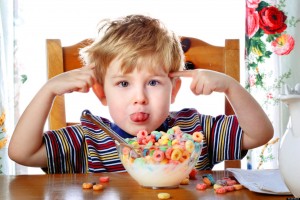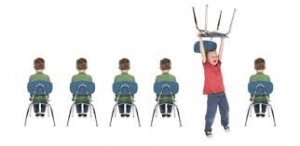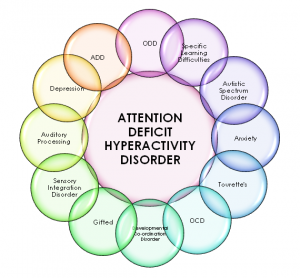Introduction:
Attention Deficit Hyperactivity Disorder – ADHD is one of the most common disorders encountered in children and most of the times the disorder is misunderstood and as a result is badly managed. ADHD can be described as a developmental disorder characterized by varying degrees of inattention, overactivity and impulsivity, arising in childhood. Sensory, language or motor impairment, mental retardation or emotional disturbance with deficits of behaviour and performance may also be seen in children suffering from ADHD.
Signs & Symptoms of ADHD –
ADHD begins in childhood. The symptoms of inattention and/or hyperactivity need to occur in a manner and degree which is inconsistent with the child’s current developmental level. That is, the child’s behavior is significantly more inattentive or hyperactive than that of his or her peers of a similar age.
Several symptoms must be present before age 12. This age requirement supports ADHD/ADD as a neurodevelopmental disorder. It is often difficult for adults (e.g., parents) to look retrospectively and establish a precise age of onset for a child.
A person can present with predominantly inattention, predominantly hyperactivity-impulsivity, or a combination of the two. To meet the diagnosis of ADHD and thereby be tagged as a child suffering from ADHD, the child must show at least 6 symptoms from the appropriate categories below:-
Symptoms of Inattention:
- Failure to give close attention to details.
- Makes careless mistakes in schoolwork, work, or other activities.
- Difficulty in sustaining attention in tasks or play activities.
- Does not listen when spoken to directly.
- Fails to follow through on instructions and fails to finish schoolwork, chores, or duties in the workplace.
- Difficulty in organizing tasks and activities.
- Avoids, dislikes, or is reluctant to engage in tasks that require sustained mental effort – such as schoolwork or homework.
- Loses things necessary for tasks or activities quite often. (e.g., toys, school assignments, pencils, books, or tools)
- Easily distracted by random stimuli.
- Tends to be forgetful in daily activities – even those which he/she performs regularly (e.g., a routine appointment)
Symptoms of Hyperactivity/Impulsivity:
Hyperactivity
- Fidgets with hands or feet or squirms in seat.
- Leaves his/her seat in classroom or in other situations in which remaining seated is expected.
- Runs about or climbs excessively in situations where it is inappropriate to do so.
- Difficulty in playing or engaging in leisure activities quietly.
- Is often “on the go” or often acts as if “driven by a motor”.
- Talks excessively almost always.
Impulsivity
- Blurts out answers before questions have been completed.
- Difficulties in waiting for his/her turn.
- Interrupts or intrudes on others. (e.g., butts into conversations or games)
For a child to be surely diagnosed with ADHD, symptoms should have persisted for at least 6 months. Some of these symptoms need to have been present as a child, at 12 years old or younger. The symptoms also must exist in atleast two separate settings (for example, at school and at home). The symptoms should be creating a significant impairment in social, academic or occupational functioning or relationships.
| DISINHIBITION | HYPERACTIVITY |
| FORGETFULNESS | DISORGANIZATION |
| INATTENTION | DISTRACTEDNESS |
Causes of ADHD –
- Genetic Factors – Some evidence exists that there is a possibility of a genetic factor which causes ADHD. Babies that are restless from birth have no time to be conditioned and hence there is a chance that genetic factor exists. Most parents of children with ADHD have a mild degree of an underlying psychological illness. Research has reported sociopathy and hysteria in the parents of hyperkinetic (hyperactive) children.
- Intelligence – ADHD usually occurs in the mentally subnormal children. These children are bubbling with energy and cannot use their energy in the right way. They present with useless overactivity. Also children with exceptional intelligence may likewise present with ADHD. These children find studies easy and cannot settle down in class. Learning difficulties were an important part of ADHD though their exact relationship is not clear. However low IQ has been found in children with ADHD than for normal children of the same age.
- Brain Damage – Any child who has suffered a brain damage is more likely to present with ADHD. In such cases, a detailed history with examination will help us diagnose ADHD due to a brain damage. Many children are mentally subnormal which depends on the degree of brain damage, though those having gross brain damage are preferably excluded from being classified as ADHD. The regions of the brain responsible for managing the attention capacity of the child receive reduced blood flow thus resulting in selective inattention and distribution i.e. inability to control and direct attraction to the demands of the task.
- The Epileptic Child – Children suffering from epilepsy are often detected as suffering from ADHD. There is a chance of ADHD, Mental Subnormality and Epilepsy being in the same patient.
- The Schizophrenic Child – Children suffering from Schizophrenia may also suffer from ADHD. But many a times the symptoms of ADHD are considered to be a part of Schizophrenia itself and hence the diagnosis of ADHD is masked.
- Scholastic Difficulties – Childrenwith Scholastic Backwardness (especially at school) may manifest with Separation Anxiety or School Phobia and thus may also come up with symptoms of ADHD. Academic failures, peer rejection, low aspirations and goals, poor adaptation to school and poor attendance in school have all been known to be associated with ADHD.
- Dietetic Factors – Vitamin deficiencies of Niacin and Pyridoxine play an important factor in ADHD. A child having a sugar-rich diet and with significant food allergies is considered to be more prone to suffering from ADHD. Hence various foodstuffs like cow’s milk, wheat flour, food dyes, citrus fruits etc are best to be avoided.
- The Overprotective Mother – There are some mothers who usually cling to their child and will not let them go and play with other children or perform any other activity. These mothers have queer notions and are neurotic and bothered about the safety and security of their children. Their children are very precious to them as they are the only son or daughter for such mothers. This kind of overprotection eventually causes a bottling up of energy thereby manifesting as ADHD in the child.
- The Disharmonious Family – In families where extensive tension anxiety and chaos prevails, the general atmosphere of tension automatically has an effect on the child thereby manifesting as ADHD. Economic deprivation, health problems, poor parental supervision, family conflict, low parental involvement and high rate of violence and alcoholism are associated with families having children suffering from ADHD.
Homoeopathic Approach in treating ADHD:
The fundamental problem in ADHD appears to be genetic. Homoeopathy looks for the underlying causes of ADHD thereby dealing with it at the root level.
ADHD treated in the conventional method is usually with the help of medical supplements which treat the inattentiveness, hyperactivity or the other behavioural problems that are seen in children with ADHD. Individual psychotherapy along with behaviour therapy is also advised during the treatment of ADHD. Homoeopathy helps in targeting the root cause of the problem and thereby deals with the causes of ADHD from within. The main aim and objective of Homoeopathy has always been to treat a person individually and relieve the patient of their symptoms from within.
Homoeopathy helps in treating the hyperactive and attention problems of an ADHD child. Homoeopathy thereby helps in improving the core nature of the child. Thus by means of which the ADHD child can continue his daily routine and lifestyle like any other normal child. The ADHD child can concentrate and pay better attention at school and at home.
The homoeopathic treatment for ADHD is based on an extensive case study of the patient with regards to his/her characteristic symptoms, genetic predisposition, and their mental state. The total time taken for the treatment differs from person to person depending on the duration, intensity and frequency of the suffering, maintaining causes, susceptibility and general health of the patient.
The goal of homoeopathic treatment for ADHD is to identify the main cause for the occurrence of symptoms. Homoeopathy then uses the body’s own mental powers to behave normally like other children. Children with ADHD have a lot of energy bottled up inside them. With the help of homoeopathy, the hyperactive behaviour of children with ADHD can be fine tuned and the health of the child can be enhanced. This leads to channelizing the energy of the child into healthy and productive work so as to let the child lead a normal life.
Children with ADHD need an outlet for all the pent up excess energy within them. This is possible through play therapies which involve making the child indulge in running and jumping in a playground, cycling, swimming etc. In case of an indoor setting, the child may be given a tub of sand to play with or a sandbag to punch on and remove his/her aggression or finger/hand painting also proves to be useful. Hence play therapies along with homoeopathy can help in streamlining all the excess energy into useful and positive fields.
Hence homoeopathic treatment along with cognitive, play therapies and behavioural training can help in improving the lifestyle of a child diagnosed with ADHD and thus let the child lead a normal life.
It is therefore advisable to choose Homoeopathy for treating your child’s hyperactive and inattentive behaviour, because it helps to deal with the behavioural troubles faced by the parents of an attention deficit hyperactive child thus letting the child live like any other normal child.
How Dr. Neha Seth can help you with your Attention Deficit Hyperactive child?
Dr. Neha Seth believes in giving the patient immediate relief with a shorter period of treatment. The prime line of treatment is to consider every disease to be a result of an allergy. The patient is first asked to get her Serum IgE levels done. The Serum IgE levels are expected to be high in every patient with symptoms. To know the allergen that is causing the disease, an allergy test is done. There are two types of allergy tests that are done – a blood test and a skin test. Usually the skin allergy test is asked for; reason being it costs 1/10th the cost of the blood test. With the help of the allergy test, the allergen is identified and treated accordingly. The patient is immediately asked to stop consuming that food item which is the primary allergen. In cases of ADHD, foodstuffs like cow’s milk, wheat flour, food dyes, citrus fruits, sugar-rich foods etc are advised not to be consumed. If the allergen isn’t a food item and it is rather something like dust, pollen or chemicals etc, then the patient is expected to minimize the exposure as much as possible and keep away from the disease causing allergen. Since the maintaining and the causative factors are now known, homoeopathy works wonderfully once these causes are removed. The parents of the hyperactive inattentive child will therefore experience a reduction in the intensity and frequency of the behavioural symptoms.
With homoeopathy, Dr. Neha Seth has shown the following changes in behaviour of children –
- The child becomes less fidgety.
- The child is less aggressive.
- The child asks fewer questions.
- Improved handwriting.
- Better academic performance at school due to increased attention span.
- Smaller children start retaining information better and reproduce it more effectively.
With effective homeopathic treatment, most children can hopefully continue at a normal school thereby avoiding special schooling and thus stay in the mainstream of society. Hence, Dr. Neha Seth and homoeopathy can help you in dealing with your hyperactive child and eventually help your inattentive hyperactive child lead a healthy, normal life.








